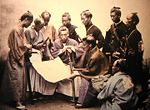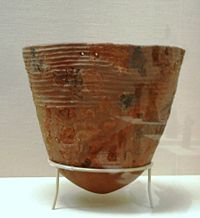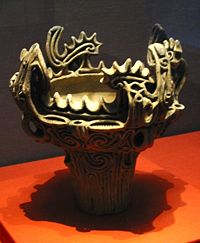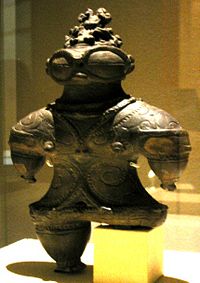Jomon culture
 History of Japan |
|---|
|
|
|
Glossary |
The Jomon period (縄文時代 Jōmon-jidai) is the time in Japanese pre-history from about 10,000 B.C.E. to 300 B.C.E.
Most scholars agree that by around 40,000 B.C.E. glaciation had connected the Japanese islands with the Asian mainland. Based on archaeological evidence, between 35,000 B.C.E. and 30,000 B.C.E. Homo sapiens had migrated to the islands from eastern and southeastern Asia and had well-established patterns of hunting and gathering and stone toolmaking. Stone tools, inhabitation sites, and human fossils from this period have been found throughout all the islands of Japan. Additionally, a 1988 genetic study points to an East Asian base for the Japanese people. [1]
The term "Jomon" means "cord-marked" in Japanese. This refers to the markings made on clay vessels and figures using sticks with cords wrapped around them.
Incipient and initial Jomon (10000 – 4000 B.C.E.)
More stable living patterns gave rise by around 10,000 B.C.E. to a Mesolithic or, as some scholars argue, Neolithic culture, but with some characteristics of both. Possibly distant ancestors of the Ainu aboriginal people of modern Japan, members of the heterogeneous Jomon culture (c. 10,000-300 B.C.E.) left the clearest archeological record. The culture was roughly contemporaneous with civilizations in Mesopotamia, the Nile, and the Indus Valley.
Early pottery

According to archaeological evidence, the Jomon people may have created the first known pottery vessels in the world, dated to the 11th millennium B.C.E. [2] , as well as the earliest ground stone tools. The antiquity of this pottery was first identified after the Second World War, through radiocarbon dating methods [3]. However, some Japanese scholars also believe that pottery production technology was first invented on the mainland because of sites in what is now China and Russia that have produced pottery "which may be as old, if not older, than Fukui Cave pottery" [4]. The Jomon people were making clay figures and vessels decorated with patterns of a growing sophistication made by impressing the wet clay with braided or unbraided cord and sticks.
Neolithic traits
The manufacture of pottery typically implies some form of sedentary life, since pottery is highly breakable and thus is useless to hunter-gatherers who are constantly on the move. Therefore, the Jomon were probably some of the earliest sedentary or at least semi-sedentary people in the world. They used chipped stone tools, ground stone tools, traps, and bows, and were probably semi-sedentary hunters-gatherers and skillful coastal and deep-water fishermen. They practised a rudimentary form of agriculture and lived in caves and later in groups of either temporary shallow pit dwellings or above-ground houses, leaving rich kitchen middens for modern anthropological study. Because of this, the earliest forms of farming are sometimes attributed to Japan (Ingpen & Wilkinson) in 10,000 B.C.E., two thousand years before their widespread appearance in the Middle East. However, some archaeological evidence also suggests early experiments with agriculture in the hills and valleys of the Fertile Crescent in modern Syria, Jordan, Turkey and Iraq around 11,000 B.C.E. [5].
Population expansion
This semi-sedentary culture led to important population increases, so that the Jomon exhibit some of the highest densities known for foraging populations [6]. Genetic mapping studies by Cavalli-Sforza have shown a pattern of genetic expansion from the area of the Sea of Japan towards the rest of eastern Asia. This appears as the third most important genetic movement in Eastern Asia (after the "Great expansion" from the African continent, and a second expansion from the area of Northern Siberia), which suggests geographical expansion during the early Jomon period [7]. These studies also suggest that the Jomon demographic expansion may have reached America along a path following the Pacific coast [8].
Main periods
Incipient Jomon (10000 - 7500 B.C.E.):
- Linear applique,
- Nail impression,
- Cord impression,
- Muroya lower.
Initial Jomon (7500 - 4000 B.C.E.):
- Igusa,
- Inaridai,
- Mito,
- Lower Tado,
- Upper Tado,
- Shiboguchi,
- Kayama.
Early to Final Jomon (4000 – 400 B.C.E.)


The Early and Middle Jomon periods saw an explosion in population, as indicated by the number of excavations from this period. These two periods correspond to the prehistoric holocene climatic optimum (between 4000 and 2000 B.C.E.), when temperatures reached several degrees Celsius higher than the present, and the seas were higher by 5 to 6 meters.[9] Beautiful artistic realizations, such as highly decorated "flamed" vessels, remain from that time. After 1500 B.C.E., the climate cooled, and populations seem to have contracted dramatically. Comparatively few archeological sites can be found after 1500 B.C.E.
By the end of the Jomon period, a dramatic shift had taken place according to archaeological studies. Incipient cultivation had evolved into sophisticated rice-paddy farming and government control. Many other elements of Japanese culture also may date from this period and reflect a mingled migration from the northern Asian continent and the southern Pacific areas. Among these elements are Shinto mythology, marriage customs, architectural styles, and technological developments, such as lacquerware, textiles, laminated bows, metalworking, and glass making.
Main periods
Early Jomon (4000 - 3000 B.C.E.):
- Lower Hanazumi,
- Sekiyama,
- Kurohama,
- Moroiso A,B,C
- Juusanbodai.
Middle Jomon (3000 - 2000 B.C.E.):
- Katsusaka/Otamadai,
- Kasori E1,
- Kasori E2.
Late Jomon (2000 - 1000 B.C.E.):
- Shyomyouji,
- Horinouchi,
- Kasori B1,
- Kasori B2,
- Angyo 1.
Final Jomon (1000 - 400 B.C.E.):
- Angyo 2,
- Angyo 3.
Notes
- ↑ [1]
- ↑
- "The earliest known pottery comes from Japan, and is dated to about 10,500 B.C.E. China and Indo-China follow shortly afterwards" ("Past Worlds" The Times Atlas of Archeology. p. 100, 1995).
- "That end of the Ice Age was accompanied by the first of the two most decisive changes in Japanese history: the invention of pottery. In the usual experience of archeologists, inventions flow from mainlands to islands, and small peripheral societies aren't supposed to contribute revolutionary advances to the rest of the world. It therefore astonished archeologists to discover that the world's oldest known pottery was made in Japan 12,700 years ago." Jared Diamond, [2].
- "Japan, however, was the seat of the earliest known development of ceramics" ("The History and Geography of Human Genes", p249, Cavalli-Sforza ISBN 0-691-08750-4.
- Alternatively, the Metropolitan Museum of Art's Timeline of Art History [3] notes "Carbon-14 testing of the earliest known shards has yielded a production date of about 10,500 B.C.E., but because this date falls outside the known chronology of pottery development elsewhere in the world, such an early date is not generally accepted". [4].
- ↑ Calibrated radiocarbon measures of carbonized material from pottery artifacts: Fukui Cave 12500 +/-350 BP and 12500 +/-500 BP (Kamaki&Serizawa 1967), Kamikuroiwa rockshelter 12, 165 +/-350 years BP in Shikoku (Esaka et al. 1967), from "Prehistoric Japan", Keiji Imamura, p46
- ↑ Junko Habu claims that "The majority of Japanese scholars believed, and still believe, that pottery production was first invented in mainland Asia and subsequently introduced into the Japanese archipelago." and explains that "A series of excavations in the Amur River Basin in the 1980s and 1990s revealed that pottery in this region may be as old as, if not older than, Fukui Cave pottery" ("Ancient Jomon of Japan", by Junko Habu, Cambridge University Press, 2004, ISBN 0-521-77213-3) [5]
- ↑ [6]
- ↑ "Jomon population densities are among the highest recorded for a foraging population, although in some areas of the Pacific Coast of North America, comparable and even higher figures of population densities have been observed (Hassan, 1975)" "The History and Geography of Human Genes" p249, Cavalli-Sforza ISBN 0-691-08750-4.
- ↑ "The third synthetic map shows a peak in Japan, with rapidly falling concentric gradients... Taken at face value, one would assume a center of demographic expansion in an area located around the Sea of Japan." "The History and Geography of Human Genes" p249, Cavalli-Sforza ISBN 0-691-08750-4
- ↑ "The synthetic maps suggest a previously unsuspected center of expansion from the Sea of Japan but cannot indicate dates. This development could be tied to the Jomon period, but one cannot entirely exclude the pre-Jomon period and that it might be responsible for a migration to the Americas. A major source of food in those pre-agricultural times came from fishing, then as now, and this would have limited for ecological reasons the area of expansion to the coastline, perhaps that of the Sea of Japan, but also father along the Pacific Coast" "The History and Geography of Human Genes" p253, Cavalli-Sforza ISBN 0-691-08750-4
- ↑ "Prehistoric Japan", Imamura
See also
- Japanese era name#Unofficial nengō system (私年号)
ReferencesISBN links support NWE through referral fees
- This article contains material from the Library of Congress Country Studies, which are United States government publications in the public domain.
- Japan
- "Ancient Jomon of Japan", by Junko Habu, Cambridge University Press, 2004, ISBN 0-521-77213-3
- "Prehistoric Japan", by Keiji Imamura, University of Hawai Press, 1996, ISBN 0-8248-1852-0
- "Subsistence-Settlement systems in intersite variability in the Moroiso Phase of the Early Jomon Period of Japan", Junko Habu, 2001, ISBN 1-879621-32-0
- Encyclopedia of Ideas that changed the World, Robert Ingpen and Philip Wilkinson, 1993, ISBN 0-670-84642-2
- "The History and Geography of Human Genes", Cavalli-Sforza, ISBN 0-691-08750-4
- The Neolithic Age in Eastern Siberia. Henry N. Michael. Transactions of the American Philosophical Society, New Ser., Vol. 48, No. 2 (1958), pp. 1-108. (laminated bow from Korekawa, Aomori)
External links
- Jomon pottery at Current World Archaeology
- Jomon Japan at jomonjapan.org
- EMuseum at Minnesota State University, Mankato The Paleolithic Period/Jomon Period
- jomonjapan.org
< Paleolithic | History of Japan | Yayoi >
ar:فترة جومون cs:Období Džómon de:Jōmon-Zeit et:Jōmoni periood es:Período Jomon fr:Période Jōmon ko:조몬 시대 id:Zaman Jomon is:Jomon it:Periodo Jōmon he:תקופת ג'ומון nl:Jomon ja:縄文時代 pl:Jōmon pt:Período Jomon ru:Дзёмон sh:Jomon fi:Jōmon-kausi sv:Jomon uk:Період Дзьомон zh:繩文時代 zh-classical:繩紋時代
Credits
New World Encyclopedia writers and editors rewrote and completed the Wikipedia article in accordance with New World Encyclopedia standards. This article abides by terms of the Creative Commons CC-by-sa 3.0 License (CC-by-sa), which may be used and disseminated with proper attribution. Credit is due under the terms of this license that can reference both the New World Encyclopedia contributors and the selfless volunteer contributors of the Wikimedia Foundation. To cite this article click here for a list of acceptable citing formats.The history of earlier contributions by wikipedians is accessible to researchers here:
The history of this article since it was imported to New World Encyclopedia:
Note: Some restrictions may apply to use of individual images which are separately licensed.

